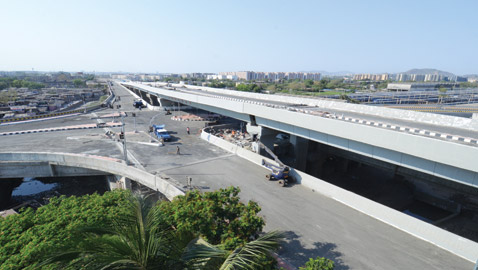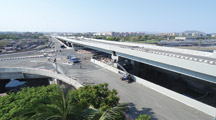
Mumbai Metropolitan Region Development Authority showcases the Santacruz-Chembur Link Road project, Mumbai’s first double-decker flyover.
The Santacruz-Chembur Link Road — Mumbai’s first double-decker flyover — is a classic example of how east-west connectivity is essential for the smooth movement of vehicular traffic in the metropolis. While the construction of the 3.5-km long flyover along with the road at grade was a challenge in itself, with a massive rehab component, the operations within a few days saw close to 75,000 vehicles plying the newly opened road.
The road project, one of the most awaited projects in Mumbai’s infrastructure scenario, is seen to decongest huge traffic chaos at three places, Sion, Bandra and Kurla.
Another significance of the project is for commuters travelling from the western suburbs towards Thane, Navi Mumbai and Pune. Earlier, these commuters had to go all the way up to Sion to get on Eastern Express Highway. Now they can simply use SCLR along with the Amar Mahal Junction flyover and reach EEH in almost one-third of the time.
Last but definitely not the least is the “rehab” component. While the project was mired in multiple court cases and eventually moved out of the “MUTP” component, thousands of shanties were demolished to pave way for the road project. Not only shanties but probably for the first time in the history of an urban infrastructure project, 13 MHADA buildings were also demolished and the occupants were relocated in the same vicinity. From railway permissions to shifting of HT wires of Tata Power, MMRDA officials faced a number of hurricane tasks to take the project to its logical conclusion.
Making of the Santacruz-Chembur Link Road is a unique example of how an urban infrastructure project can be carried out even in worst case scenarios, if planning is done in a meticulous manner.
Santacruz-Chembur Link Road was aimed at easing traffic snarls at Amar Mahal Junction, Vakola, Sion and Kula and also significantly decongest Eastern and Western Express Highways. This project would also reduce traffic chaos at Sion and Kalanagar junctions. It would enable commuters to travel from Santacruz to Chembur in a mere 15-20 minutes. As noted earlier, Mumbaikars required anywhere between 60 to 90 minutes to cross this stretch during peak hours.
Project challenges
SCLR, which was a part of Mumbai Urban Transport Project, is considered to be one of the most challenging projects according to Mumbai Metropolitan Region Development Authority.
Any construction in a complex urban area poses a challenge to the engineers. SCLR was one such challenging project with a huge missing link, thousands of shanties and even authorised structures coming in the Right of Way of the project. Work on the flyover began in 2003.
As expected, the Rs.428-crore project faced innumerable court cases, various issues related to resettlement and rehabilitation, encroachments etc. However, MMRDA successfully resettled and rehabilitated more than 3,500 project affected families from Gazi Nagar, Buddha Colony, Sable Nagar, Rahul Nagar and Indira Colony areas. This included residential, commercial and even religious structures.
Besides, MMRDA also shifted 13 MHADA buildings from Tilak Nagar and two MHADA buildings from Netaji Nagar, Kurla. While the occupants of the 13 buildings from Tilak Nagar were rehabilitated “in-situ”, the occupants of the two MHADA buildings from Netaji Nagar were rehabilitated in Bandra-Kurla Complex.
MMRDA also spent Rs.100 crore for rehabilitation and resettlement of encroachments on railway land.
The demolition, shifting and relocation of 15 MHADA buildings, is acknowledged as a “model-case-study” in the developing world.
The project execution also required coordination with the Railways. The first two 51-metre long girders, weighing 140 tonnes, were launched on November 2013, over Central Railway lines between Kurla and Vidyavihar connecting Santacruz and Chembur. The Railways had handed over a 21-day schedule offering three-hour blocks every night.
Project outcome
The Santacruz-Chembur Link Road has proved to be a major relief for traffic movement on Eastern Express Highway. Besides providing the excellent east-west connectivity, the vital link road is being used by more than 75,000 vehicles on a daily basis, reducing a major burden on the arterial highway.
The traffic burden on EEH has considerably eased now. Besides, travel distance from the eastern to western suburbs has also reduced by approximately an hour.
Using SCLR, motorists can save time to get to Western Express Highway and to Bandra-Kurla Complex. On the other hand, motorists going towards Sion and other parts of South Mumbai can also enjoy a traffic-free ride.










